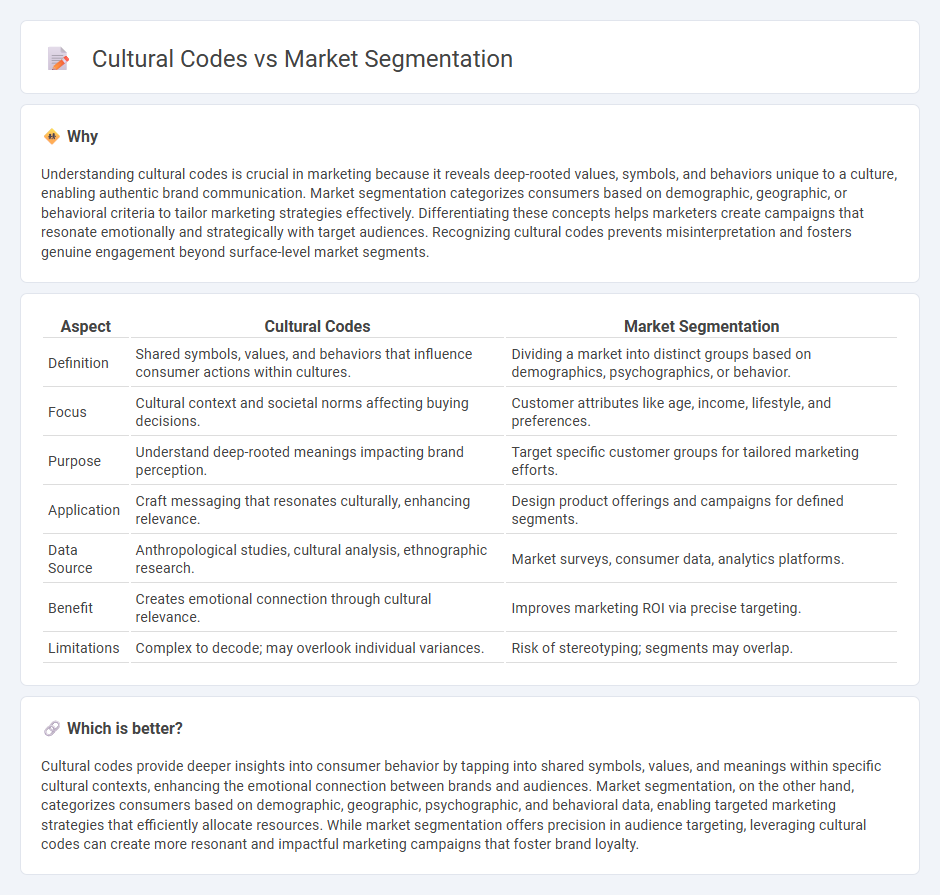
Cultural codes are shared symbols and meanings that influence consumer behavior within specific communities, while market segmentation divides a broad market into distinct groups based on demographics, psychographics, or behavior. Understanding cultural codes enables marketers to create more authentic and resonant messages tailored to each segment. Explore how integrating cultural insights with segmentation strategies enhances marketing effectiveness.
Why it is important
Understanding cultural codes is crucial in marketing because it reveals deep-rooted values, symbols, and behaviors unique to a culture, enabling authentic brand communication. Market segmentation categorizes consumers based on demographic, geographic, or behavioral criteria to tailor marketing strategies effectively. Differentiating these concepts helps marketers create campaigns that resonate emotionally and strategically with target audiences. Recognizing cultural codes prevents misinterpretation and fosters genuine engagement beyond surface-level market segments.
Comparison Table
| Aspect | Cultural Codes | Market Segmentation |
|---|---|---|
| Definition | Shared symbols, values, and behaviors that influence consumer actions within cultures. | Dividing a market into distinct groups based on demographics, psychographics, or behavior. |
| Focus | Cultural context and societal norms affecting buying decisions. | Customer attributes like age, income, lifestyle, and preferences. |
| Purpose | Understand deep-rooted meanings impacting brand perception. | Target specific customer groups for tailored marketing efforts. |
| Application | Craft messaging that resonates culturally, enhancing relevance. | Design product offerings and campaigns for defined segments. |
| Data Source | Anthropological studies, cultural analysis, ethnographic research. | Market surveys, consumer data, analytics platforms. |
| Benefit | Creates emotional connection through cultural relevance. | Improves marketing ROI via precise targeting. |
| Limitations | Complex to decode; may overlook individual variances. | Risk of stereotyping; segments may overlap. |
Which is better?
Cultural codes provide deeper insights into consumer behavior by tapping into shared symbols, values, and meanings within specific cultural contexts, enhancing the emotional connection between brands and audiences. Market segmentation, on the other hand, categorizes consumers based on demographic, geographic, psychographic, and behavioral data, enabling targeted marketing strategies that efficiently allocate resources. While market segmentation offers precision in audience targeting, leveraging cultural codes can create more resonant and impactful marketing campaigns that foster brand loyalty.
Connection
Cultural codes influence consumer behavior and perceptions, making them essential for effective market segmentation in marketing strategies. By analyzing cultural symbols, values, and norms, marketers can create tailored segments that resonate deeply with specific groups, enhancing engagement and brand loyalty. Understanding these cultural nuances enables precise targeting and customized messaging, driving better market penetration and conversion rates.
Key Terms
Demographics
Market segmentation involves dividing a broad consumer or business market into sub-groups based on shared characteristics, with demographics such as age, gender, income, education, and occupation playing a critical role in identifying target audiences. Cultural codes, on the other hand, encompass the shared values, beliefs, and symbols that influence consumer behavior within specific demographic groups, helping marketers tailor messages that resonate on a deeper emotional and cultural level. Explore more to understand how integrating demographic data with cultural codes enhances marketing strategies for precise audience engagement.
Psychographics
Market segmentation based on psychographics categorizes consumers by their lifestyle, values, interests, and personality traits, enabling tailored marketing strategies that resonate on a deeper emotional and behavioral level. Cultural codes influence these psychographic profiles by embedding shared symbols, beliefs, and social norms that shape consumer attitudes and decision-making processes within specific cultural contexts. Explore how integrating psychographics with cultural codes enhances the precision and cultural relevance of market segmentation for more effective targeting.
Semiotics
Market segmentation categorizes consumers based on demographic, psychographic, and behavioral traits to tailor marketing strategies effectively. Cultural codes, rooted in semiotics, decode symbols, signs, and shared meanings within a culture that influence consumer perceptions and behaviors. Explore how integrating semiotic analysis with market segmentation enhances targeted communication and brand resonance.
Source and External Links
Market segmentation - Market segmentation is the marketing process of dividing a consumer or business market into meaningful sub-groups called segments, which share common characteristics, allowing companies to target profitable segments with distinct strategies using the S-T-P (Segmentation, Targeting, Positioning) framework.
What is Market Segmentation? A Guide | Salesforce US - Market segmentation divides a broader target market into smaller groups based on shared attributes such as demographics, psychographics, behavioral patterns, and geography, enabling tailored marketing strategies that resonate with specific consumer needs and motivations.
What is market segmentation? | Overview and examples - Market segmentation is the process of dividing a broad target market into subsets of customers with common needs, priorities, or behaviors, allowing marketers to develop tailored messaging and targeted campaigns for each defined cluster to optimize engagement and growth.
 dowidth.com
dowidth.com